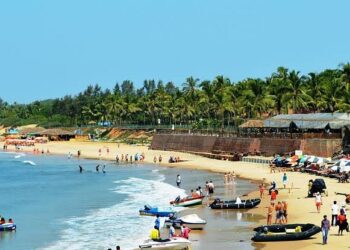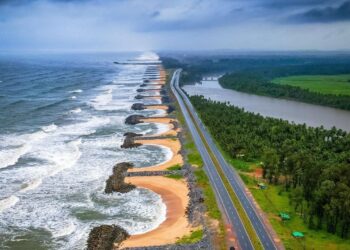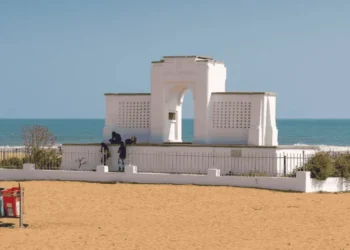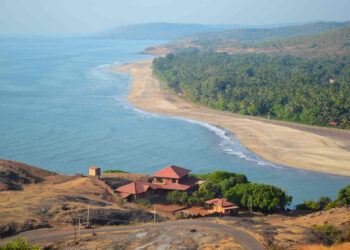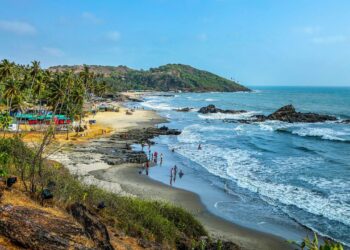In Naimisharanya, Sitapur district, Uttar Pradesh, near the Gomti River, the Naimisharanya Temple, also called Chakratirtha or Neemsar, is a sacred place where people come to worship Lord Vishnu. This temple is one of the Divya Desams, the 108 holy Vishnu temples celebrated in the Nalayira Divya Prabandham by the twelve Alvar saints. Among them, Thirumangai Azhvar specifically praised this site. In fact, the entire city is regarded as a Divya Desam, not just the temple alone.
History of Naimisharanya Temple
The Naimisharanya Temple was made around the 7th century by local kings of the Gupta dynasty. Naimisharanya, known as a holy forest in the Mahabharata and Vishnu Purana, is a sacred town tied to Hindu tales. Local talk says the temple was built to honor Vishnu, who appeared here as a chakra (divine disc) to guide sages. Records from 800 mention fixes by King Harsha, and the temple is noted in the Skanda Purana’s Naimisha Khanda.
The temple sits on a flat plain near Chakratirtha, a holy pond. In the 12th century, Islamic raiders destroyed it, but the Rajput lords rebuilt it in the 1500s. In 1800, British writers noted its sage gatherings. After 1947, the state trust took charge.
Legends of Naimisharanya Temple
The temple is tied to various stories of Lord Vishnu and local talk. One main story says Vishnu’s chakra fell here, forming Chakratirtha, to mark a spot for sages to study. Devotees believe Vishnu still protects Naimisharanya, and praying here with a true heart brings his blessings and takes away troubles, as he is known for his mercy in the Vishnu Purana.
The temple is recognized as one of the eight Swayamvyakta Kshetras, where Lord Vishnu is believed to have manifested on His own. Devotees consider the nearby Chakra Kunda and the Gomati River to be sacred, often taking ritual baths there during special festivals. Close to the site is the Nava Narasimha Swamy Temple, maintained by the Uttara Ahobila Mutt, further enriching the spiritual landscape of the region.
According to legend, Indra, the king of the devas, was once ousted from Devaloka by the asura Vritra. Vritra had received a powerful boon that made him immune to all weapons known at the time, as well as those made from wood or metal. Seeking help, Indra turned to Lord Brahma, who advised him to worship Lord Vishnu in the sacred Naimish forest. Indra undertook a penance there for 2000 years. Pleased with his devotion, Vishnu revealed that Vritra could only be defeated by a weapon crafted from the bones of the sage Dadhichi. When Indra approached the sage and explained the situation, Dadhichi willingly gave up his life for the greater good. Using the sage’s spine, Indra fashioned the mighty vajra, or thunderbolt, and with it, he finally defeated Vritra.
Another tale says the idol was set by Rishi Sandipani, a saint who saw Vishnu in a vision in the 7th century. The saint placed the idol after Vishnu’s holy touch blessed it. Local stories tell of wonders, like devotees finding peace, wisdom, or help with problems after praying here, keeping the temple sacred. Some say a hidden spring under Chakratirtha holds Vishnu’s spiritual presence. These tales, passed down by followers, bring people to pray for Vishnu’s blessings and feel his holy presence.
Architecture of Naimisharanya Temple
The Naimisharanya Temple sits on two acres near Chakratirtha, made in a simple North Indian style. The main part has a low stone top, carved with Vishnu’s conch, disc, and lotus, all in white stone. Inside, the Vishnu idol, 5 feet tall and covered in yellow paste, stands with a conch in his right hand and a chakra in his left. A 2-foot idol of Lakshmi, his wife, is nearby, lit by oil lamps.
A small hall has four stone pillars, carved with Vishnu’s avatars and sages. Lesser shrines for Hanuman, Rama, and Shiva are in the yard, made of stone. The Hanuman shrine shows him with a mace, for strength. The Rama one, from 1100, has him with a bow, for truth. The Shiva one shows a lingam, for power. The stone yard feels holy, near the Gomti. A plain gate has Vishnu’s face. A water ghat, Gomti’s edge, is for ritual dips. Pillars tell Vishnu’s tales, guiding those who pray.
Information for Travelers
Hours and Entry: Open every day, 5:00 AM to 9:00 PM. It’s free to enter, but prayers cost ₹50–200. No pictures in the inner room.
Clothing: Wear clothes covering shoulders and knees. Women for prayers wear sarees or suits, men wear kurtas.
How to Get There:
Air: Lucknow Airport, 90 km away, links to Delhi (1 hour), Mumbai (2 hours). Taxis take 2 hours, cost ₹2000–3000.
Train: Sitapur Station, 25 km away, links to Lucknow (2 hours), Delhi (8 hours). Autos cost ₹100–150.
Road: Naimisharanya is 90 km from Lucknow, 150 km from Kanpur on NH 27. Buses from Lucknow reach Naimisharanya. Autos from the town center are also available.
Best Time to Visit: October to March is cool, 15–25°C. Weekdays are quiet. Janmashtami’s full, with 20,000–40,000 devotees, so plan early.
Nearby Attractions
Chakratirtha: 0.5 km away, a holy pond tied to Vishnu’s chakra.
Lalita Devi Temple: 2 km away, a Durga shrine from 1000.
Dadichi Kund: 3 km away, a pond tied to Sage Dadichi’s sacrifice.
Gomti River Ghat: 1 km away, a bath spot for prayers.

